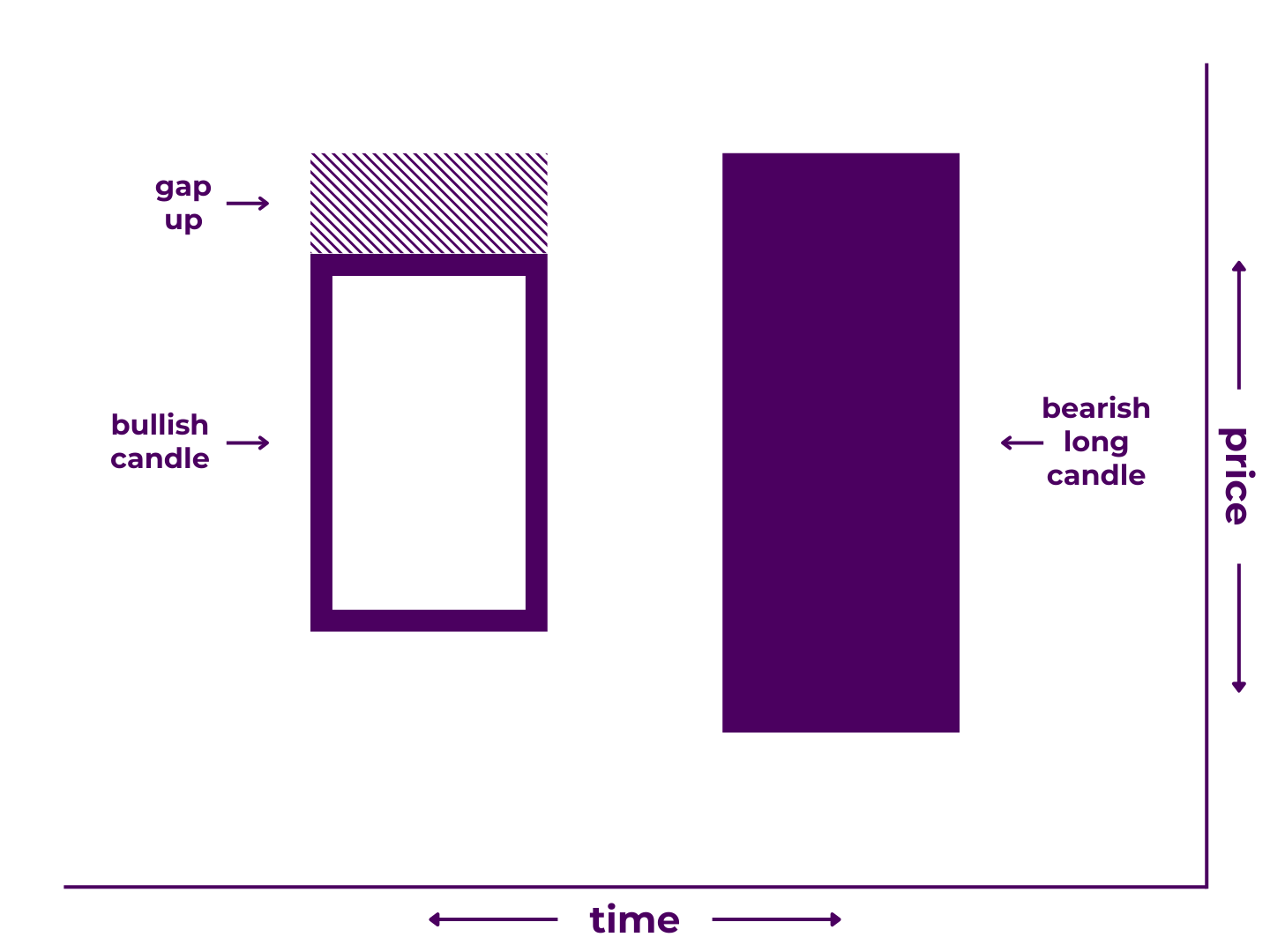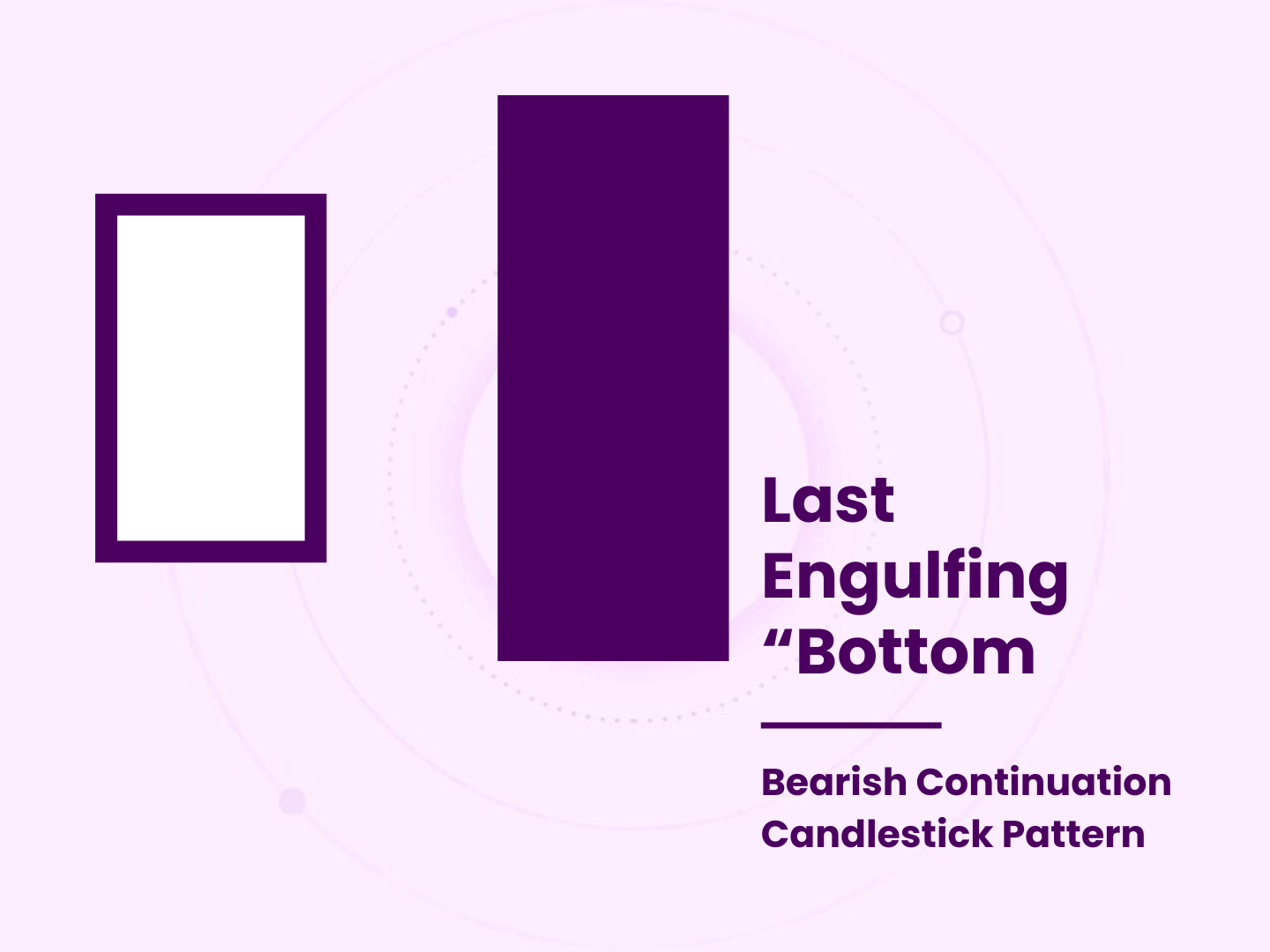Last engulfing bottom patterns are a nuanced but relatively high-performing candlestick pattern.
Learning how to read and trade them adds a valuable weapon to your trading arsenal. Most technical analysis is based on Japanese candlestick charts, after all. In this post, we’ll go over everything you need to know to trade last engulfing bottom candle patterns.
Last Engulfing Bottom Pattern Guide
To start, let’s define them.
What Is a Last Engulfing Bottom Candlestick Pattern?
A last engulfing bottom is a bearish continuation formation. They occur during downtrends and consist of 1) a large-bodied candlestick moving up and 2) a large-bodied candlestick moving down that opens above and closes below the body of the first.
***Please note, many sources list the last engulfing as a reversal pattern. However, various quantitative analyses show that it actually acts as a continuation pattern, which matches the way the pattern looks.

It is the bearish version of the last engulfing pattern, and therefore the opposite of the last engulfing top pattern. It is a variation of the bearish engulfing pattern and therefore related to the three outside down.
Of course, no candlestick pattern guarantees a particular outcome. They are more like suggestions than promises.
So, what do last engulfing bottom patterns really tell you?
What Last Engulfing Bottom Patterns Mean
The name last engulfing bottom is a bit of an issue.
The “engulfing” part fits, as you could describe the second candlestick as consuming the first one. However, the “bottom” part implies a bullish reversal. In reality, it functions more like a bearish continuation signal. This makes it a fairly misleading name. Consequently, it may be a smart idea to treat all bearish engulfing candles as bearish signals instead of reversal or continuation signals.
In trading terms:
- First Period – The price increases significantly, contrary to the downward trend.
- Pre/Post-Market Trading – The price increases modestly.
- Second Period – The price decreases significantly, closing lower than the open of the prior period.
This helps reinforce the ongoing downtrend. If sellers can keep price below the formation, bearish continuation becomes all but inevitable. Furthermore, it creates several decision zones that may become important resistance levels in the future.
Figuratively, last engulfing bottom candles indicate that the bears may have swallowed the bulls’ pullback attempt whole.
How To Recognize Last Engulfing Bottom Candlestick Patterns
Patterns are attractive partly because they stand out.
To the untrained eye, they may mean nothing. But to those with experience, they are something like a beacon. They draw your attention to a specific segment of price action, encouraging you to look more closely.
To gain this insight, all you need to do is learn the rules and practice finding them on the charts.
By definition, a last engulfing bottom pattern has several requirements.
- It must appear during a general downtrend.
- The first candle must be a bullish long-line candlestick.
- The second candle must be a bearish long-line candlestick.
- The second candle must open above the first candle’s body.
- The second candle must close below the first candle’s body.
As you can see, most of this pattern’s rules center around the second candlestick.
However, some exceptions may be acceptable.
- The first candle can be a neutral candle (ie. a doji), as long as it is fully contained within the body of the second.
- The first candle can be bearish, as long as it is fully contained within the body of a bearish second candle.
- The open of the second candle can be even with the close of the first candle, especially in markets where gaps are less common like cryptocurrency.
- The second candle doesn’t necessarily have to be a long candle, as long as it fully contains the body and wicks of the first.
You may find better results by stretching some of these criteria (or even adding your own). For instance, your analysis may reveal that last engulfing bottom patterns in which the second candle sets a new local low perform more reliably than those that do not. Or, you may find something else entirely.
Technically, these variations may fall more accurately under other candlestick reversal patterns, or none at all.
This is okay though, as implication supersedes classification. And similar patterns usually have similar implications (though not always).
Yet, that does not mean that these standards are wholly irrelevant. In fact, certain ones are definitely mandatory, such as the second candle closing below the body of the first. It just means that deeper examination may help you identify more and/or better trading opportunities.
Ultimately, how seriously you take each of these guidelines is up to you. Don’t forget that the purpose of analyzing candlestick patterns is to interpret underlying price action. Your pattern labeling skills are less important.
To this end, you need to understand where they fit.
Where Last Engulfing Bottoms Fit in the Chart Narrative
The markets are often described as a battle between the bulls and the bears.
Last engulfing bottom patterns show that the bulls attempted to take control on candle one (and between candles one and two) but then surrendered the momentum back to the bulls completely by the end of candle two.
On the chart, it looks like an ill-fated top attempt.
The first day played out in a surprising fashion, with a powerful move against the downtrend. During post and premarket trading, it continued to rise. Due to low confidence in their ability to change the trend, some buyers decided to take profit on their short-term trades. This led to a cascade of selling action throughout the day, erasing the bulls’ day one push.
The stage is now set for a fight over the levels highlighted by this price action. If buyers cannot retake these levels, the chance of a bearish continuation increases.
Please note: This is only an illustration. Last engulfing bottom candlesticks can reflect any number of real-world scenarios.
In the short-term, it amounts to a rebellion snuffed out.
The question for traders:
“Is continuation imminent or will the bulls try to force a local low again?”
To answer that question, you’ll need more than an understanding of Japanese candlesticks and candlestick patterns. You’ll want to evaluate both within the context of longer-term chart patterns as well as trend and price levels. You’ll also want to make use of your own chart markup and indicators.
Explore the history of your preferred asset(s) with respect to last engulfing candlestick patterns and apply your findings to your own trading style.
The more thorough your technical analysis, the more clear the story in the charts becomes.
How To Trade Last Engulfing Bottom Candle Patterns
Bearish continuation points are great places to add to your short position or adjust your stop loss.
As such, last engulfing bottom candle patterns serve as easy-to-spot signs of unchanging bearish momentum. They may even lead to the next big leg down.
In most cases, you can assign greater weight to multi-stick patterns than single candles because they provide more information over a longer duration. However, you should wait for all candles to close before making any decisions. Otherwise, there is a good chance that you’ll get caught in a fake out.
Additionally, there are a few other things you should consider before trading candlestick patterns.
First and foremost, they are never a “sure thing.” According to Bulkowski’s Encyclopedia of Candlestick Patterns, last engulfing bottoms have a hit rate of 65% (while last engulfing tops have a hit rate of 68%). Sure, that is pretty decent but definitely not a certainty.
What’s more, candlestick patterns do not have uniform price targets or measured moves like chart patterns do. That makes position management trickier.
Plus, failed continuation patterns often lead to reversal or consolidation. Thus, you’d be wise to seek additional confirmation factors to increase your odds of a successful trade.
Plus, failed reversal patterns often lead to continuation or. Thus, you’d be wise to seek additional confirmation factors to increase your odds of a successful trade.
Some of these include:
- Volume – For continuation, you typically want to see reduced trading volume against the trend. That means low volume on the first candle of a last engulfing bottom may be a good omen.
- Price Formations – Bearish continuation patterns tend to perform better when there is thin (or non-existent) resistance above them. The further below and weaker the better.
- Matching Momentum – Oscillating indicators like the RSI or stochastics are commonly used to identify continuation by analyzing slope, percentile, and/or divergence.
The more corroborating elements are present, the more confident you can be about the strength of a bearish last engulfing continuation signal.
Even so, it would be difficult to form a successful trading strategy built around any single candlestick pattern. There simply isn’t enough there to develop a strong edge. It would still be suboptimal with an expert understanding of trading math, order execution, market psychology, risk management, options, and automation.
In essence, last engulfing patterns are more useful idea givers than trade makers.
Better yet, you’ll probably find more success building your strategy around other tools and using candlestick patterns as the final point of confirmation.
Other Candlestick Pattern Types
There are many bearish continuation candlestick patterns.
The last engulfing bottom is only one.
Likewise, there are many bullish continuation candlestick patterns. Not to mention, you have bearish reversal candlestick patterns and bullish reversal candlestick patterns.
For most traders though, tackling all candlestick patterns at once may be the best learning path.
- Abandoned Baby – Bearish | Bullish
- Breakaway – Bearish | Bullish
- Counterattack Lines – Bearish | Bullish
- Doji Star – Evening | Morning
- Engulfing – Bearish | Bullish
- Gap Three Methods – Upside | Downside
- Harami – Bearish | Bullish
- Harami Cross – Bearish | Bullish
- In Neck – Bearish | Bullish
- Kicking – Down | Up
- Ladder – Top | Bottom
- Mat Hold – Bearish | Bullish
- Matching – High | Low
- Meeting Lines – Bearish | Bullish
- On Neck – Bearish | Bullish
- Separating Lines – Bearish | Bullish
- Star – Evening | Morning
- Stomach – Below | Above
- Tasuki Gap – Downside | Upside
- Three Inside – Down | Up
- Three Methods – Falling | Rising
- Three Outside – Down | Up
- Three-Line Strike – Bullish | Bearish
- Tri-Star – Bearish | Bullish
- Tweezer – Top | Bottom
- Window – Falling | Rising
Sure, it is quite a long list.
Luckily for us all, you don’t need to memorize every pattern and its criteria. Instead, focus on price action and technical analysis principles. The goal is to be able to look at any group of candlesticks and understand what they mean.
The more candlestick patterns you study, the easier this will become.
Takeaways
To review:
Last engulfing bottom candlesticks are a type of pattern that signal a potential bearish continuation. While not a guarantee, their appearance may indicate that sellers are primed to remain dominant. When used properly, this can help you find winning trades.
Of course, there are other candlestick patterns that you should learn about. Still, the ability to recognize patterns is not enough to trade successfully on its own.
Nonetheless, you’ve now added one more weapon to your trading arsenal.
Have questions or more information to add? Contribute to the conversation in the comments below! Or, if you know someone who could benefit from this post, share it with them. You can also check out our Candlestick Patterns Guide to improve your candlestick analysis skills.


0 Comments